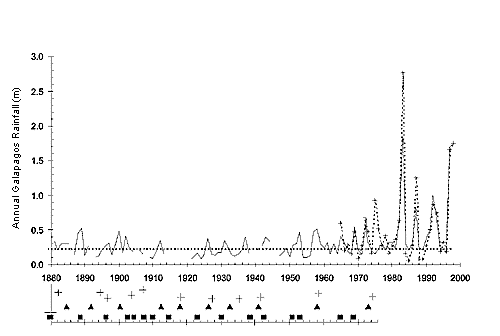El Niño
Introduction:
El Niño tends to create consistently high sea-surface temperatures in the tropical Pacific and weak winds which causes large amounts of water to evaporate into the atmosphere, which later on creates strong convective storms of great rainfall. Usually, El Niño last between twelve and eighteen months, cycling with La Niña, which causes severe droughts.
Problem:
El Niño's cycles have become more frequent in the past 5,000 years, reoccurring every two to 8.5 years, doubling the rate of the previous 10,000 years. The intensity of its climatic events has also increased, partly due to global warming.
“Since 1965, there have been five strong El Niño events in Galápagos: 1975-76, 1982-83, 1986-87, 1993-94, and 1997-98” (Snell 2000).
“For the last 118 years, it appears that the amounts of rainfall and the strength of El Niño events remained relatively constant until the current period, when the amounts of rain during El Niño events increased. If these estimated patterns reflect the real trends, the Galápagos Archipelago could be entering one of the wettest periods in its history” (Snell 2000).
Figure 1. Estimated Rainfall on the Galapagos:

Squares and triangles indicate, respectively, moderate and severe El Niño events, as determined from historical records. Plus signs indicate El Niño events as determined by a study of organic deposits in an Andean lake.
Figure 2. Rainfall and Temperature on Santa Cruz Island:

El Niño and the Galapagos:
El Niño's conditions allow for organisms in the Galapagos to flourish, whereas they suffer during the dry La Niña. “It is possible that the combinations of reduced reproductive success, increased mortality, and spread of alien species could make modern El Niño events damaging for terrestrial organisms” (Snell, 2000).
El Niño and Marine Organisms:
Populations of marine ecosystems were greatly reduced during the 1997-1998 El Niño. Possibly half of the sea lion and marine iquana populations dropped, along with Galapagos penguins. “Many other species of seabirds failed to reproduce and may have experienced increased mortality of adults.” (Snell, 2000)
El Niño and the Galapagos Tortoises:
In the case of terrestrial populations, the Galapagos tortoises failed to reproduce as the increased vegetation and wet soil reduced the nest temperatures below the embryos range for survival. If the eggs did hatch, the increase in population of the introduced Solenopsis (fire ant) due to El Niño caused high infant mortality. In addition: adults were killed by the frequent floods and banks of steep ravines formed by El Niño.
El Niño and the Dark-billed Cuckoos:
The cuckoos on Santa Cruz were the only exception to the population change caused by El Niño. Their numbers exploded during the summer of 1998; however, shortly afterward, sights of dead cuckoos were frequently reported to the Charles Darwin Research Station (CDRS) and the National Park Service (NPS).
El Niño and Introduced Species:
Amphibians:
Most species do not survive the Galapagos once reaching the islands due to the arid and sparsely vegetated land. However, the 1997-1998 El Niño allowed for the first-time the establishment of amphibians (frogs) on the islands. A member of the Leptodactylidae family established a colony in Puerto Villamil on Isabela. In Puerto Ayora on Santa Cruz, the Scinax quinquefasciata, of the Hylidae family did also.
Birds:
Several introduced species migrated and spread to other islands as a result of the wet conditions caused by El Niño. The Smooth-billed Anis created new populations on Genovesa and Fernandina, from Santa Cruz.
Cattle:
The 1997-1998 El Niño created higher populations in the herds. The farmers petitioned the GNP to allow grazing in the park, and as a result they disturb the smaller species in the Scalesia canopy while grazing. They also introduce several plants in the form of seeds through their manure.
Related Links: